Related Research Articles
Padarn Beisrudd ap Tegid was the son of a Bishop named Tegid ap Iago, who may have been born with the Roman name of Tacitus. Padarn is believed to have been born in the early 4th century in the Old North of Roman Britain. According to Old Welsh tradition, his grandson, King Cunedda, came from Manaw Gododdin, the modern Clackmannanshire region of Scotland.
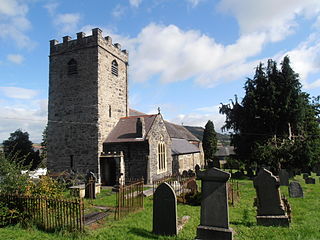
Saint Mael and Saint Sulien's Church is a church located in the town of Corwen in Denbighshire in Wales. It was formerly located in the ancient county of Merionethshire.

Maentwrog is a village and community in the Welsh county of Merionethshire, lying in the Vale of Ffestiniog just below Blaenau Ffestiniog, within the Snowdonia National Park. The River Dwyryd runs alongside the village. Its population of 585 in 2001 increased to 631 at the 2011 Census. The Community of Maentwrog includes the village of Gellilydan.

Afan of Builth was an early 6th-century Welsh bishop, martyr, and saint. His feast day is generally placed on 17 November, although the Demetian Calendar formerly used in southern Wales placed it on the 16th; it is no longer observed by either the Anglican or Catholic church in Wales.
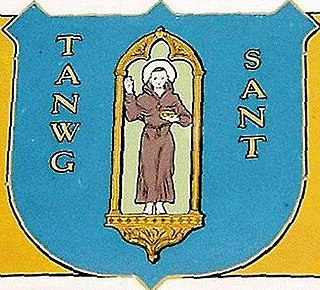
Saint Tanwg is the patron saint of Llandanwg, Gwynedd, Wales. He is presumed to be the founder of St Tanwg's Church, the small church at Llandanwg near Harlech, although the presence of an inscribed stone which has been dated to the 5th century suggests the church was already in existence when Tanwg and his brothers arrived in the area early in the 6th century. This Llandanwg Stone is inscribed with two names, one being Ingenui ; the other is indecipherable. The stone is not local. It is thought to have come from the Wicklow Hills in Ireland. This means that it was probably brought over by a rich person. It is a reasonable conjecture that Ingenuus may have been the founder of the church in the late fifth century, and that St. Tanwg lived at this llan a generation or two later. Another stone, called the Equester Stone, is of 6th century date. It is inscribed Equestrinomine, an unusual form of wording otherwise known only from 4th century inscriptions in Italy and Gaul.
Clemen ap Bledric was a 7th-century King of Dumnonia.
Cadfan, sometimes Anglicized as Gideon, was the 6th century founder-abbot of Tywyn and Bardsey, both in Gwynedd, Wales. He was said to have received the island of Bardsey from Einion Frenin, king of Llŷn, around 516 and to have served as its abbot until 542.

Saint Twrog's Church is in the village of Maentwrog in the Welsh county of Gwynedd, lying in the Vale of Ffestiniog, within the Snowdonia National Park. It is in the Deanery of Ardudwy. It is designated by Cadw as a Grade II listed building.
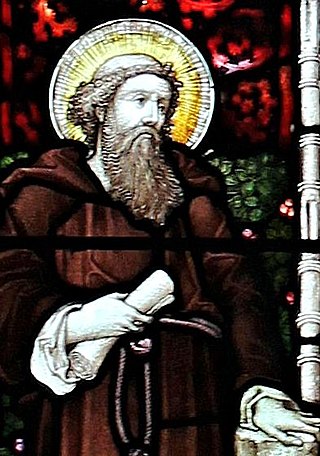
Saint Twrog - feast day 26 June - was a 6th-century Welsh saint who founded the church at Maentwrog, having come to Wales early in the Age of the Saints.

Saint Tegai is the patron saint and founder of Llandygai in the Welsh county of Gwynedd.
Ithel Hael or Ithel Hael o Lydaw was a prince of Armorica who lived in the early part of the sixth century. He was the father of Baglan, Flewyn, Gredifael, Tanwg, Twrog, Tegai, Trillo, Tecwyn and Llechid, saints who accompanied Cadfan to Britain.
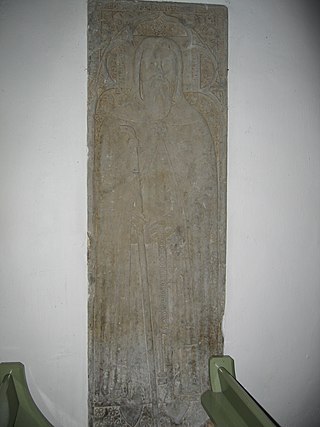
Iestyn was a Welsh hermit and confessor in the 6th or 7th century who is venerated as a saint. He was the founder of two churches, one in Gwynedd and another in Anglesey, both in north Wales.
Saint Peulan was a Welsh holy man in the early part of the 6th century, the son of Paulinus, a saint from south Wales who taught Saint David. A follower of Cybi, a saint associated with the island of Anglesey in north Wales, Peulan is commemorated in the dedication of the church he reportedly founded, St Peulan's Church, Llanbeulan, on Anglesey.
Elaeth was a Christian king and poet in Britain in the 6th century who is venerated as a saint. After losing his territory in the north of Britain, he retreated to Anglesey, north Wales, where he lived at a monastery run by St Seiriol at Penmon. Some religious poetry is attributed to him, as is the foundation of St Eleth's Church, Amlwch, also in Anglesey.

Eisingrug is a rural hamlet near Harlech, Gwynedd, Wales. It is located to the southeast of Porthmadog.
Tyfrydog was a Christian from north-west Wales in the fifth or sixth century, who was later venerated as a saint. He is said to have established a church in Anglesey, and although no part of the original structure remains, the current church is still dedicated to him. A nearby standing stone is said to be the remains of a man who he punished for stealing a bible from the church.
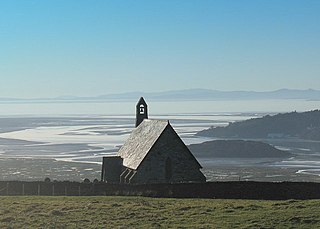
Llandecwyn is a hamlet near Penrhyndeudraeth in Gwynedd, Wales.
Cynfarwy was a Christian in the 7th century about whom little is known. He was venerated by the early church in Wales as a saint, although he was never formally canonised. St Cynfarwy's Church in Anglesey is dedicated to him, and his name is also preserved in the name of the settlement around the church, Llechgynfarwy. His feast day is in November, although the date varies between sources.

A Saint Ilar is listed among the 6th-century saints of Wales and is the probable namesake of Llanilar in Ceredigion and its former hundred of Ilar. His feast day is variously given as 13, 14, or 15 January, but is no longer observed by either the Anglican or Catholic church in Wales.

Llanfihangel-y-traethau was a parish in Ardudwy, Gwynedd, north-west Wales centred on a church of the same name in the village of Ynys. The original parish church was built in the 12th century on a tidal island. Later the land rose and connected the island to the mainland. Today it is part of the Bro Ardudwy ministry area, which includes Harlech, a few miles (kilometres) to the southwest, and Barmouth. The church has a window depicting Saint Tecwyn and is the start of the Saint Tecwyn's Way, a pilgrimage route ending at Saint Tecwyn's church in Llandecwyn.
References
- ↑ The Roman and British Martyrology: . O'Neill & Duggan. 1846. Retrieved 8 October 2022.
- 1 2 Williams, Robert (1852). Enwogion Cymru: A Biographical Dictionary of Eminent Welshmen, from the Earliest Times to the Present, and Including Every Name Connected with the Ancient History of Wales. Llandovery.
{{cite book}}: CS1 maint: location missing publisher (link) - ↑ "The Arrival of St Tecwyn - image from Stained Glass in Wales". stainedglass.llgc.org.uk. Retrieved 19 August 2020.